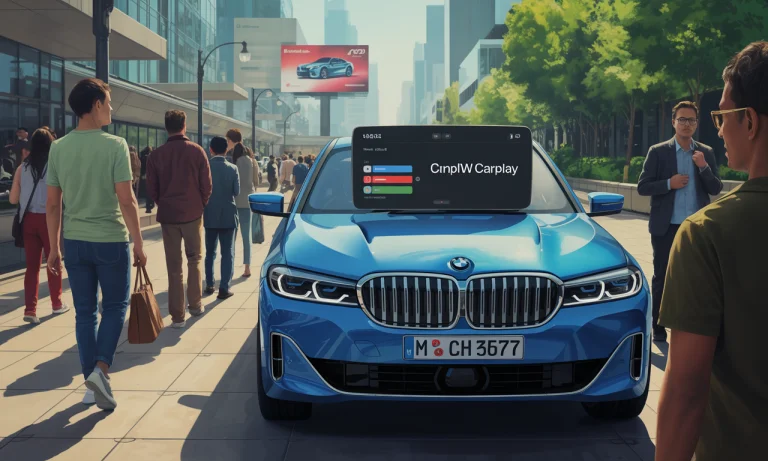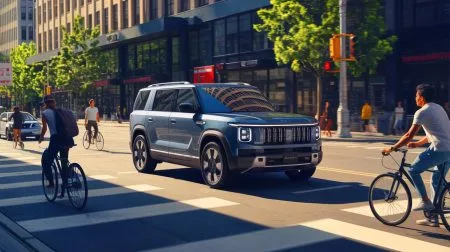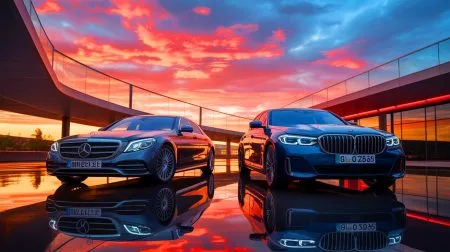At a time when Apple CarPlay has become synonymous with modern driving, a surprising narrative emerges from the heart of Germany. While surveys insist that most buyers refuse to consider a new car without smartphone integration like CarPlay or Android Auto, some automakers see things differently. BMW is at the center of this debate, presenting evidence from more than 10 million vehicles suggesting drivers aren’t as attached to Apple’s in-car experience as the world believes. The automaker’s confidence isn’t just anecdotal—its data paints a nuanced portrait of driver habits, challenging assumptions about technology, brand loyalty, and the future of digital dashboards. As the industry evolves, stories of change ripple through showrooms from Munich to Detroit, and drivers everywhere are left wondering which interface truly enhances their journey.
BMW’s Take on Apple CarPlay: Examining Real Usage Trends
In stark contrast to industry rumors, BMW has set out to bust what it calls the “CarPlay myth.” Speaking with conviction, Stephan Durach—BMW’s Senior Vice President of UI/UX Development—referenced years of usage data to challenge the belief that CarPlay navigation reigns supreme among BMW drivers. As new models roll out, including the tech-focused iX3 and iDrive X system, Durach’s team has observed that drivers often keep CarPlay enabled for familiar phone features. Yet, when it comes to navigation, the majority actually return to BMW’s own iDrive solution. This observation draws a line in the sand against the idea that Apple’s software dominates behind the wheel.
The numbers don’t lie—BMW’s datasets suggest a majority still trust in-built navigation over Apple Maps or even Google Maps via CarPlay. Unlike Tesla and Rivian, both of which have never pursued Apple or Google integration, BMW’s position stems not from resistance to change, but from a measured analysis of customer preferences.
| Interface | Frequency of Use (BMW Data) | Notes |
|---|---|---|
| BMW iDrive Navigation | High | Preferred for driving directions and system integration |
| Apple CarPlay Maps | Moderate | Used for media, less frequently for navigation |
| Google Maps/Waze via CarPlay | Unclear | Data insufficient, but likely secondary |
From Tech Buzz to Driving Reality: Do BMW Owners Really Need CarPlay?
For years, Apple and tech analysts contended that CarPlay and Android Auto were indispensable ingredients in new cars. Marketplace surveys fueled this belief, hinting that brands forgoing CarPlay would risk losing out to competitors like Porsche, Volkswagen, and others pushing deeper digital integration. As the infotainment wars intensified, tech enthusiasts speculated whether consumer choice would dictate which brands rose or fell.
Reality on the highway, however, tells a different story—at least in BMW’s case. Even as General Motors shocks the market by removing CarPlay from its EV lineup and Volkswagen touts its own digital advances (see how VW approaches family travel here), BMW’s research suggests that drivers love the reassurance and tighter integration of automaker-designed infotainment. It’s not just about access to playlists; it’s about seamless control over vehicle functions and a unified driving experience. That difference resonates as buyers evaluate cars that are increasingly complex, connected, and sometimes intimidating. For more on connectivity, visit this IoT feature.
The Infotainment Shift: How BMW Bets on iDrive X Over Apple’s Ecosystem
With the debut of its Panoramic Display and iDrive X infotainment, BMW marks a subtle but consequential pivot in its digital strategy. Rather than embracing Apple CarPlay Ultra, the German marque aligns with Audi, Mercedes-Benz, Polestar, and Volvo—opting against third-party dashboard integration. BMW’s official position for 2025 could be described as pragmatic: support continues for classic CarPlay, but without extending to the immersive, full-dashboard “Ultra” iteration just launched by Apple for iOS 26.
Automotive insiders have wondered whether this is a risk. Yet, by controlling the digital environment—and declining to support third-party navigation apps like Google Maps or Waze on the Panoramic Display—BMW argues it can deliver smoother software upgrades, better integration, and enhanced control over evolving car technology. Technology buffs interested in the pace of advancement across the entire market can read more in this feature on car technology advancements in 2025.
| Brand | CarPlay/Android Auto Support | Built-in Infotainment Priority |
|---|---|---|
| BMW | CarPlay (no Ultra), Android Auto (possible phase-out) | iDrive X, Panoramic Drive |
| Audi | Limited, no Ultra | Own infotainment system |
| Mercedes-Benz | Limited, no Ultra | MBUX system |
| Tesla | None | Proprietary system only |
| Volkswagen | Advanced CarPlay | Own system, family focus |
What About Everyday Drivers: Is BMW’s Strategy Really Meeting Customer Needs?
Imagine a scene on a European highway: a family sets off on their summer holidays in a new BMW iX3. The kids want to stream music through CarPlay, while the parents rely on the car’s native navigation, trusting its up-to-date traffic and direct communication with the vehicle’s safety systems. In moments like these, BMW’s argument for sticking with in-house solutions gains credibility. The balancing act between familiar smartphone convenience and vehicle-focused feature depth defines the modern driving experience. Selecting a car now involves considering not just style or speed, but questions like, “Can I get the tech I want?” For parents seeking the best family-ready EVs, options like those ranked here become central to the debate.
BMW isn’t alone in this fine-tuning of infotainment priorities. Competitors like Audi and Mercedes-Benz have voiced similar skepticism about full-on CarPlay Ultra adoption, while brands like Tesla continue to bet exclusively on their own technology stacks. For drivers trying to choose the right SUV for their lifestyle, weighing the merits of integration can be as critical as horsepower or trunk space, as explored in guides such as this one.
Looking Ahead: Car Buyers, Connectivity and the Evolving User Experience
If the past decade made Apple CarPlay a standard bearer for in-car technology, 2025 marks a turning point. Some automakers, emboldened by internal data and unique consumer insights, are charting their own course. Their approach highlights the shifting dynamics in which drivers weigh the value of seamless smartphone integration versus robust, feature-rich proprietary systems. BMW’s contrarian stance is less about denying “digital natives” what they want, and more about leading the conversation toward experiences they believe only automaker-designed interfaces can deliver.
For buyers chasing affordability and tech in their next vehicle, models on the horizon—like those previewed here—offer a window into what’s next. Whether it’s the integration of IoT, advancements in AI-driven safety, or the promise of cleaner electric powertrains, the car of tomorrow is now defined as much by digital personality as mechanical muscle. For a deeper look at testing the latest electric innovations, check out this review of an industry first here.
| Driver Need | BMW Solution | CarPlay/Android Auto Alternative |
|---|---|---|
| Navigation | iDrive X, Panoramic Display | Apple Maps, Google Maps (limited support) |
| Media/Entertainment | iDrive Streaming Services | Apple CarPlay, Android Auto |
| Vehicle Controls | Deep integration, custom features | Limited to Apple/Google commands |
Are You Choosing Tech or the Badge? What BMW, Apple, and Drivers Will Decide Next
Stories surface every week—like the tech reviewer who, after a decade with CarPlay, welcomed the tighter controls of iDrive, or a longtime Porsche enthusiast who found Volkswagen’s family-first approach more appealing after a demo (more on urban SUVs). Today’s car purchase isn’t just about horsepower or badge prestige. It’s a negotiation with the digital world, with each journey pressed between personal preference, product cycles, and the relentless evolution of mobile tech. As new contenders and partnerships arise, the question persists: whose ‘ecosystem’ will truly define the future of the road?
Questions About Apple CarPlay, BMW, and the New Infotainment Landscape
Is Apple CarPlay disappearing from all BMW models?
BMW continues to offer classic Apple CarPlay across its range, but currently has no plans to support the fully immersive CarPlay Ultra upgrade. Newer systems like iDrive X prioritize the brand’s in-house features, particularly for navigation and system controls.
Are other luxury brands following BMW’s lead on infotainment?
Yes, Audi and Mercedes-Benz have expressed similar reservations about adopting CarPlay Ultra, focusing instead on strengthening their proprietary infotainment systems. Meanwhile, Tesla remains committed to using only its own software without CarPlay or Android Auto support.
Will I still be able to use my phone’s navigation in a new BMW?
While you can use navigation via classic Apple CarPlay or Android Auto on most BMW models, new systems with Panoramic Display may restrict third-party app integration, prompting drivers to rely more on built-in solutions like iDrive.
Does this strategy affect the resale value of BMW vehicles?
It could, especially for buyers who prioritize connectivity. Trends indicate that some consumers value seamless smartphone integration, which can factor into future resale considerations. However, a robust proprietary system can also be seen as a premium feature for many.
What if I want the ultimate smartphone integration in my car?
Check each model’s tech specs, as the digital landscape can change rapidly. Brands like Volkswagen and Porsche currently emphasize advanced integrations, while others, like BMW, are focused on refining their native systems for the best balance of safety, technology, and ease of use.
Did you like it? 4.4/5 (20)







